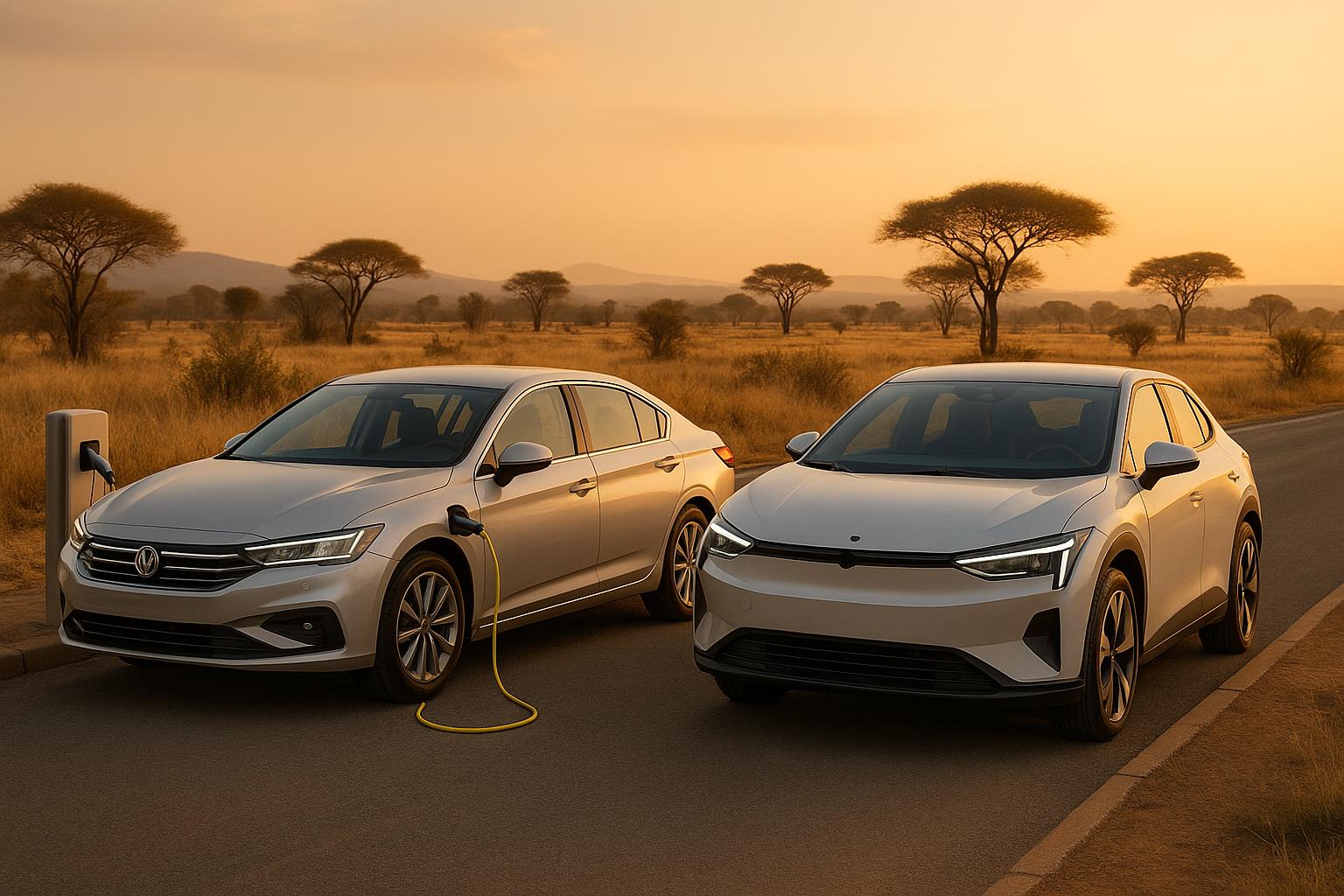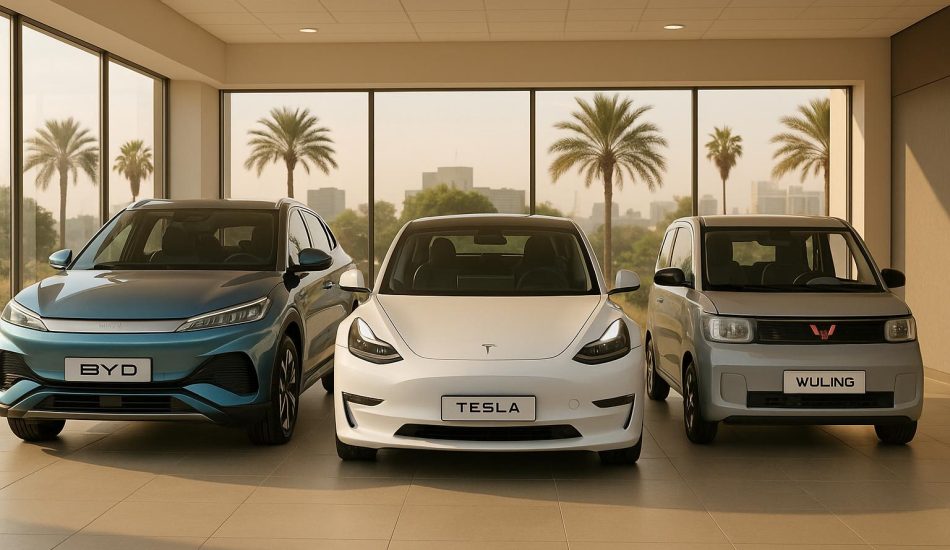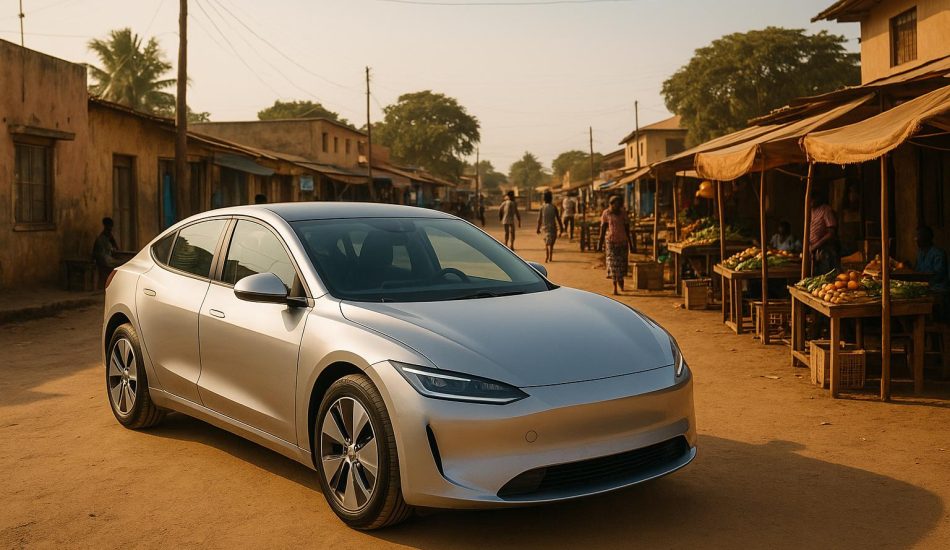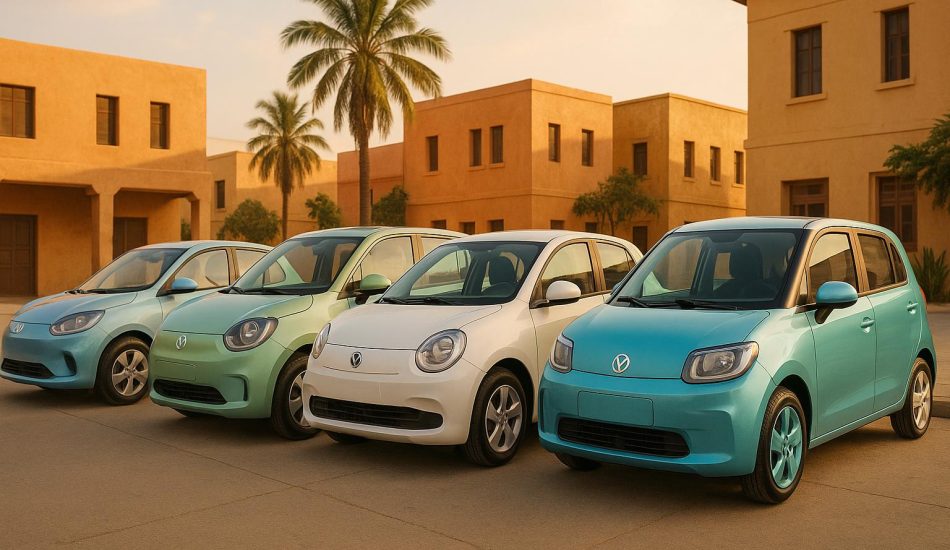
Choosing between Plug-in Hybrid Electric Vehicles (PHEVs) and Battery Electric Vehicles (BEVs) in Africa boils down to infrastructure and individual needs. PHEVs offer flexibility with a gasoline engine for long trips and an electric motor for short commutes, making them ideal for areas with limited charging networks. BEVs, fully electric and emission-free, work best in cities with reliable electricity and charging stations.
Key Points:
- PHEVs: Use gasoline and electricity, ideal for rural areas or regions with unreliable power grids.
- BEVs: Fully electric, better suited for urban areas with established charging networks.
- Challenges: Limited charging infrastructure, high import costs, and inconsistent policies affect adoption.
- Costs: PHEVs often have lower maintenance costs; BEVs offer lower running costs in the long term.
- Climate: BEVs reduce emissions in areas with renewable energy; PHEVs balance emissions with flexibility.
Quick Comparison:
| Feature | PHEVs | BEVs |
|---|---|---|
| Power Source | Gasoline + Electric Motor | Fully Electric |
| Range | Combines electric and gasoline range | Limited to battery capacity |
| Infrastructure Needs | Relies on existing fuel stations | Requires a strong charging network |
| Cost | Lower maintenance; higher upfront | Higher upfront; lower running costs |
| Best For | Rural areas and long trips | Urban areas with charging stations |
PHEVs provide a practical bridge where charging networks are scarce, while BEVs are a cleaner, long-term solution in cities. The choice depends on where you live and your driving habits.
Will electric cars work in South Africa? In-depth discussion with Alex Parker
Infrastructure: Charging Networks and Power Grid Status
Africa’s infrastructure plays a key role in determining the practicality of plug-in hybrid electric vehicles (PHEVs) and battery electric vehicles (BEVs). Here’s a closer look at how charging networks, grid reliability, and fuel station availability influence vehicle adoption.
Public Charging Station Availability
In urban areas, investments have brought fast-charging stations to commercial hubs and major highways, making longer BEV trips more feasible. However, these charging points are largely concentrated in city centers. This urban focus leaves rural areas underserved, creating significant challenges for widespread BEV adoption across the continent.
Power Grid Stability and Electricity Access
For BEV owners, a stable and reliable power supply is essential. Even in regions with developed grids, power outages and voltage inconsistencies can complicate home charging. Beyond urban zones, the situation becomes more challenging, with intermittent electricity access and lower electrification levels making it difficult to rely solely on BEVs. These issues highlight the importance of exploring alternative charging solutions or the flexibility offered by PHEVs, which are less dependent on consistent electricity.
Fuel Station Networks for PHEVs
PHEVs have a distinct advantage thanks to Africa’s extensive gasoline infrastructure, which provides dependable refueling options even in areas with limited electrification. This network has been a cornerstone of mobility for decades, ensuring convenience for drivers who travel long distances or live in regions where electricity access is unreliable. Additionally, the widespread availability of service centers for traditional internal combustion engines adds another layer of practicality for PHEV owners. These factors suggest that, for now, PHEVs may be a more viable option than BEVs in many parts of Africa.
Cost Analysis and Ownership Expenses
Understanding the overall costs of owning a vehicle – purchase, operating, and financing – is key to making an informed decision.
Purchase Prices and Import Taxes
The price tag on electric vehicles (EVs) is shaped by technology and local tax policies. Battery Electric Vehicles (BEVs) often come with advanced battery systems, while Plug-in Hybrid Electric Vehicles (PHEVs) include the added flexibility of a dual powertrain. On top of that, import duties and taxes can significantly impact the final purchase price. These factors play a big role in determining the long-term affordability of these vehicles.
Operating and Maintenance Expenses
PHEVs tend to shine when it comes to lower maintenance costs. For instance, maintaining a PHEV over 200,000 miles costs roughly $4,600, compared to $9,200 for a traditional gasoline-powered car. This cost advantage is largely due to reduced engine wear over time.
What’s more, charging PHEVs using home solar systems can make them an even smarter financial choice. This is especially true in areas where solar energy is plentiful, or where grid electricity is either expensive or unreliable.
Financing Options and Market Access
Financing plays a critical role in vehicle ownership, especially when weighing the costs of EVs. Platforms like EV24.africa are stepping in to simplify this process by offering diverse financing options and clear pricing details. These tools empower buyers to compare the total ownership costs of PHEVs and BEVs, helping them make decisions that align with their budgets.
Ultimately, these cost considerations – alongside infrastructure and performance – help shape the best EV choice for different regions and markets.
sbb-itb-99e19e3
Daily Use and Consumer Needs in Africa
Understanding how electric vehicles (EVs) fit into daily life in Africa means looking at usage patterns, infrastructure hurdles, and consumer preferences across cities like Lagos and Nairobi.
Driving Range and Daily Requirements
For urban commuters in Africa, daily travel often involves short distances, making battery electric vehicles (BEVs) a practical choice for city driving. However, rural and intercity travel can be more demanding, creating unique challenges.
Plug-in hybrid electric vehicles (PHEVs) offer a versatile solution. They combine an electric range for everyday city commutes with a gasoline engine for longer trips. This dual capability is especially useful in areas where charging infrastructure is still expanding, helping to ease concerns about running out of power during trips between major cities.
Additionally, Africa’s high temperatures can affect battery performance. In such conditions, the gasoline engine in PHEVs serves as a reliable backup, ensuring consistent performance and addressing range limitations. These factors directly influence how consumers plan for charging and refueling.
Charging and Fueling Options
PHEVs stand out for their ability to combine home charging with refueling at existing gasoline stations, making them a practical choice in regions with limited charging networks. This flexibility is particularly appealing as Africa continues to develop its EV infrastructure.
For urban drivers with dependable electricity access, home charging is a convenient option for both BEVs and PHEVs. Public charging stations, on the other hand, are unevenly distributed across the continent. While some countries have made significant investments in charging networks, others are still in the early stages of development.
Given Africa’s abundant sunshine, solar-powered charging presents an exciting opportunity to support EV adoption. However, the cost of setting up a home solar charging system can be a barrier for many consumers. These considerations play a key role in determining the availability of vehicles and the models best suited to the region.
Vehicle Models and Brand Selection
The African electric vehicle market is steadily growing, though the variety of models remains more limited compared to traditional gasoline-powered options. EV24.africa offers a range of top brands, including Tesla, BYD, Hyundai, and Toyota, across all 54 African countries.
Popular BEV models like the Tesla Model 3, known for its extended range, are available alongside practical options from established manufacturers, making it easier for consumers to transition to electric mobility. For those seeking flexibility, models like the Toyota Prius Prime and Hyundai Tucson PHEV provide enough electric range for daily commutes while retaining the ability to handle longer trips.
Most EVs in Africa are imported, and delivery times can vary depending on the vehicle’s origin and destination. EV24.africa’s delivery network helps ensure access across the continent, though reaching remote areas may require additional coordination. Established manufacturers with a longer presence in the region often provide better service coverage compared to newer entrants.
Financing options, such as those offered by EV24.africa, address the higher upfront costs of EVs by offering tailored solutions that reflect diverse income levels and regional conditions. These financing plans, combined with reliable service networks, play a crucial role in helping consumers decide between BEVs and PHEVs in Africa.
Climate Impact and Government Support
Electric vehicles (EVs) in Africa come with unique environmental and policy considerations, offering both challenges and opportunities for battery electric vehicles (BEVs) and plug-in hybrid electric vehicles (PHEVs).
Emissions and Climate Effects
BEVs produce zero tailpipe emissions when powered by renewable energy, making them a cleaner option in regions with green electricity sources. However, in areas where fossil fuels dominate the energy grid, charging BEVs can still contribute to indirect emissions. On the other hand, PHEVs combine electric-only driving for short trips with gasoline use for longer distances. This creates a mixed emissions profile that varies based on driving patterns and the energy mix in a given area. Additionally, both BEVs and PHEVs have manufacturing-related emissions, which are gradually offset through their efficient operation over time.
These complexities highlight the critical role of government actions in shaping the environmental impact of EVs.
Government Policies and Incentives
To address these environmental and infrastructural challenges, several African governments have introduced policies to encourage EV adoption. Measures such as reduced import duties, tax incentives, and programs to develop charging infrastructure are becoming more common. Some nations are also promoting local EV manufacturing to build a more self-reliant industry. These initiatives aim to balance the advantages of BEVs with the adaptability of PHEVs, while also tackling the region’s economic and infrastructure hurdles.
In addition, broader strategies are being implemented to integrate renewable energy into transportation systems and support large-scale fleet conversions. These efforts collectively contribute to advancing sustainable mobility across the continent.
The success of EVs in Africa will ultimately depend on how well technology choices align with local energy grids, economic realities, and supportive policy frameworks.
Conclusion: Best Electric Vehicle Choice for Africa
When it comes to choosing the right electric vehicle for Africa in 2025, the decision largely depends on local infrastructure and consumer needs. The choice between Plug-in Hybrid Electric Vehicles (PHEVs) and Battery Electric Vehicles (BEVs) boils down to how well the regional charging networks can support these technologies.
PHEVs shine in areas where charging infrastructure is still developing. Their dual powertrain – combining an internal combustion engine with an electric motor – offers flexibility, making them a practical option in countries where urban centers have charging stations, but rural areas are still underserved. On the other hand, BEVs are a better fit for regions with established and reliable charging networks. They are particularly suited for urban fleets, government agencies, and delivery services operating in cities equipped with dedicated charging facilities. In these scenarios, BEVs can provide lower running costs and a smoother driving experience.
For budget-conscious buyers, used PHEVs from reputable brands available through platforms like EV24.africa present a cost-effective way to embrace electric mobility. These vehicles are especially appealing in areas with emerging charging networks and come with flexible financing options across all 54 African countries.
As the market evolves, supportive policies will play a critical role in fostering a balanced transition. Policymakers can help by expanding access to electricity and introducing favorable tax incentives for both PHEVs and BEVs. While BEVs are expected to dominate in the future as infrastructure improves and battery prices drop, PHEVs serve as a practical stepping stone, allowing consumers to experience the benefits of electric driving today while paving the way for a fully electric future.
Ultimately, the success of electric vehicles in Africa will depend on aligning the technology with local realities. Both PHEVs and BEVs have important roles to play in shaping the continent’s journey toward sustainable transportation.
FAQs
What are the cost and maintenance differences between PHEVs and BEVs for African drivers?
For drivers in Africa, Battery Electric Vehicles (BEVs) come with a notable advantage: lower maintenance costs. On average, BEVs cost about $900 per year to maintain. This is largely because they have fewer moving parts and skip the need for services like oil changes, making them a more economical choice over time.
In contrast, Plug-in Hybrid Electric Vehicles (PHEVs) are pricier to maintain, with annual costs hovering around $1,200. The reason? PHEVs rely on both an electric motor and an internal combustion engine, meaning upkeep is required for two systems instead of one. While BEVs offer savings on maintenance, their higher initial price tag might still influence the decision-making process for many consumers across Africa.
What are the main obstacles to building reliable charging stations for BEVs in rural Africa?
Building dependable charging stations for BEVs in rural Africa comes with its own set of hurdles. A key challenge is the unsteady electricity supply in many rural areas. Frequent power outages and unstable grids make it tough to ensure consistent charging availability. On top of that, the lack of energy infrastructure in remote regions adds another layer of complexity.
Another obstacle is the high cost of installation and upkeep, especially in sparsely populated areas where the demand for charging stations tends to be lower. Transporting equipment to these remote locations also presents logistical challenges, further complicating efforts to establish the necessary infrastructure. Overcoming these barriers will demand creative approaches and targeted investments that address the specific needs of the region.
How do government policies and incentives impact the adoption of electric vehicles in Africa?
Government policies and incentives are playing a key role in making electric vehicles (EVs) more affordable and accessible across Africa. Countries like Rwanda, Kenya, and South Africa have introduced measures such as reduced import duties, VAT exemptions, and tax breaks for EV-related investments. These steps are designed to lower the upfront costs of EVs, making them a practical choice for both consumers and businesses.
Some governments are also providing subsidies for EV purchases and encouraging local manufacturing through financial incentives. By reducing financial hurdles and supporting local production, these initiatives are helping to create a strong foundation for EV adoption, paving the way for cleaner and more sustainable transportation across the region.




